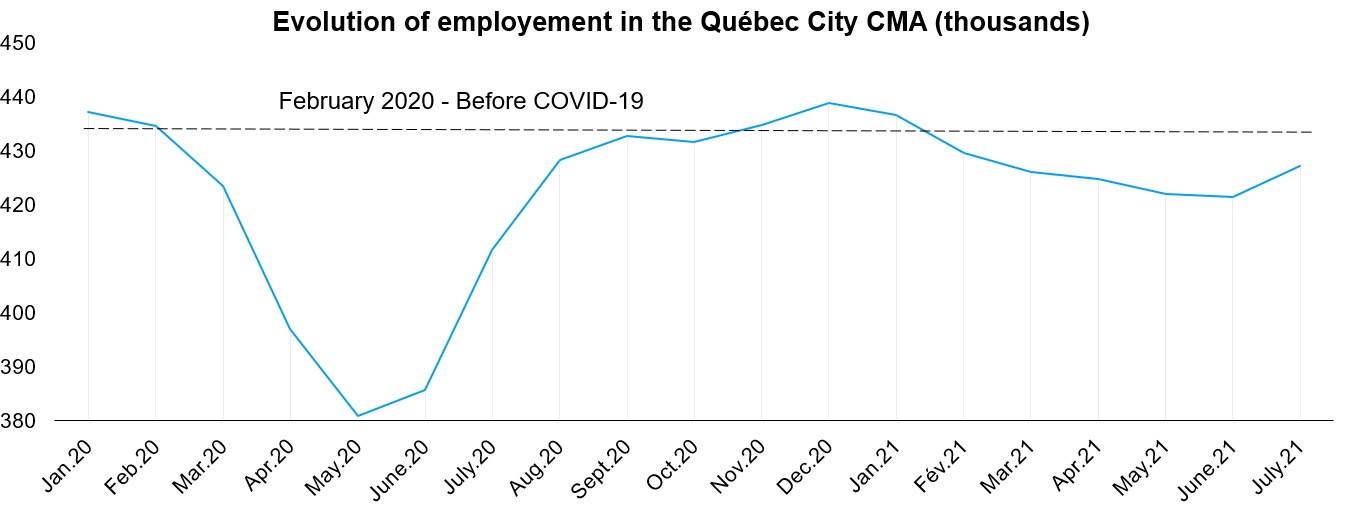Highlights
- The Québec City census metropolitan area (CMA) registered a gain of 8,600 jobs (+2.0%) in August, as the market rose back to the level registered before the COVID-19 pandemic (February 2020). Moreover, the gains in Québec City represent almost 40% of all jobs created in the province in August.
- The number of unemployed people in the region was estimated at 20,000 in August, slightly more than before the pandemic (18,700 unemployed people) but significantly lower than at the same time in 2020 (29,300 unemployed people).
- The unemployment rate grew slightly, reaching 4.4% in August, a level comparable to the 4.1% registered in February 2020.
- According to Statistics Canada’s estimations, there were 2,400 more active workers in the labour market in August 2021 compared to February 2020.
- Comparable data for the province of Quebec shows an increase of 23,000 employed people (+0.5%) in August, whereas the unemployment rate dropped to 6.1%.
Charts


Commentary
Statistics Canada’s Labour Force Survey (LFS) data for August shows the labour market conditions during the week of August 15 to 21, 2021. It provides a view of the situation as the province of Quebec is at the “green” alert level for the second month in a row. In addition, on August 9, for the first time since March 2020, vaccinated Americans were allowed to enter Canada for non-essential travels, without mandatory quarantine. Note that the measures in force across the country vary from province to province.
Employment continues to improve
Statistics Canada estimated that there were 435,800 people employed in the Québec City CMA, which is explained by a gain of 8,600 jobs (+2.0%) in August. Therefore, market labour growth continued for the second month in a row, with 37% of all jobs created in the province of Quebec registered in the Québec City region. After a difficult spring, the number of jobs has now surpassed the level registered before the pandemic (+0.3%).
Labour force above pre-pandemic levels
Statistics Canada estimated that the number of active workers—either employed or looking for work—grew by 10,800 people in August (+2.4%), bringing the total to 455,800. This is the highest monthly increase among major Canadian CMAs. Compared to February 2020, there are now 2,400 more active workers in the region’s labour market (+0.5%).
The participation rate, i.e. active workers in proportion to the working-age population, went from 64.7% in July to 66.2% in August in the Québec City CMA. Despite this increase, the labour market participation rate remains 0.1 percentage points below that of February 2020 (66.3%). The employment rate grew from 62.1% in July to 63.3% in August. This rate is now 0.3 percentage points below the pre-pandemic level (63.6%).
Unemployment is low
The number of unemployed people grew by 2,100 people (+11.7%) in August, reaching an estimated total of 20,000. This is higher than the pre-pandemic number (+7.0%) registered in February 2020. With these results, one year and a half after the beginning of the crisis, the region stands out, as the number of unemployed people is much higher than before the pandemic in both the Montréal CMA (+32.0%) and the province of Quebec (+23.8%). Note that during the same period in 2020, there were 29,300 unemployed people in Québec City.
The unemployment rate grew by 0.4 percentage points, reaching 4.4% in August. Québec City is the region with the lowest unemployment rate among major Canadian CMAs. Additionally, not only is the unemployment rate now lower than the 6.4% registered in the Québec City CMA in August 2020, it is now close to the 4.1% from before the health crisis (February 2020).
To learn more about the labour market, keep an eye out for an upcoming detailed analysis and a publication on vacant positions in the region.
Cautionary Note
The available data for the Québec City census metropolitan area (CMA) was given special statistical treatment (three-month moving average) due to the small sample size, which has the effect of mitigating the large fluctuations in the data. Thus, the data collected in June and July influenced the estimations published for the month of August. Please also note that we use comparable data for the province of Quebec and other CMAs in this document.
Émile Émond
Economist
Québec International




